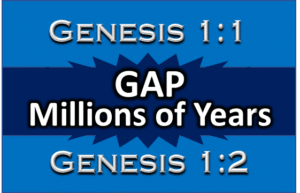Colossians 2:8
By Mike Riddle
The first chapter of Genesis provides us with a clear account of God’s creation and what was created on each of the six days. However, not all Christians agree on some of the details. For example, many start with the assumption that scientists have proven the earth is billions of years old and then this evidence is integrated into the framework of the Bible. The gap theory is one of these attempts to reinterpret the plain reading of Genesis 1.

While there are different versions of the gap theory, the popular version inserts millions of years of geological time between the first two verses in the Bible (Genesis 1:1 and 1:2). It was in 1814 that Dr. Thomas Chalmers, founder of the Free Church of Scotland, popularized what has become known as the gap theory. The idea was further popularized by a footnote in the Scofield Reference Bible in 1909.

The gap theory was a method of reconciling the secular teaching of long ages by the geologists of the time with the Bible. Gap theorists wanted a way to insert millions of years into Scripture and still maintain a literal account of a 6-day creation. Not all gap theorists agree on the details of the theory, but the one unifying principle between the different versions is that there was a large gap of time (generally millions of years between Genesis 1:1 and 1:2). According to most gap theorists, the original creation in Genesis 1:1 was perfect. It included all the plant and life-forms we currently find in the fossil record. Because of Lucifer’s rebellion and fall, God brought judgment on the creation. This rebellion and judgement took place in the gap between Genesis 1:1 and 1:2 and destroyed all life and is responsible for the geologic ages and fossil record we observe today. Starting in Genesis 1:3 restoration began with a 6-day re-creation. However, there are some serious theological issues with the gap theory.
10 concerning questions about the gap theory
Question 1: Does a belief in the gap theory mean no one understood the biblical account of creation until secular geologists figured it out for us (the popular belief in millions of years)?
Questions 2: According to the popular version of the gap theory the geologic ages and the fossil record occurred in the gap between Genesis 1:1 and 1:2. If this is true then what effect did the Genesis Flood have?
“The Gap Theory tacitly assumes that Noah’s Flood (to which Moses devotes three entire chapters in Genesis) was comparatively insignificant from the standpoint of its geological and hydrodynamic effects, since all the major fossil-bearing formations were laid down by the supposed Flood of Genesis 1:2 (sometimes referred to by Gap theorists as Lucifer’s Flood).”
John Whitcomb, Th.D., The Early Earth, 2002, p. 115.
Question 3: Since most fossils are found in sediments laid down by water does this mean there was a catastrophic flood in the gap that was responsible for the fossil record? If so, then why does the Bible spend three chapters teaching about the Genesis Flood and none about the gap flood?
Question 4: If the gap theory is true, why does the Bible spend two chapters in Genesis teaching about the “re-creation” and none about the “original” creation before the gap?
Question 5: Did God’s judgment during the gap also destroy the sun, moon and stars? If not, then why did God have to create them again on day 4 of the “re-creation”? To state that they could not be seen before day 4 of the re-creation because they were hidden by clouds is making up a story and inserting it into the Bible. How many stories not mentioned in the Bible have to be made up to defend the gap theory?
Question 6: Why did God take so long as millions or billions of years (the supposed length of the gap) before He re-created everything? Was God confined to wait for billions of years of natural processes before His re-creation? What was the purpose for waiting so long? God’s judgement of the Genesis Flood took just over a year.
Question 7: Proponents of the gap theory, as well as many other supporters of long ages, claim they do not believe in evolution. However, long ages (billions of years) is the very foundation for evolution. The Bible is not dependent on billions of years. It allows for everything in a span of about 6,000 years. In addition, nowhere in the Bible is there any account of billions of years.
Question 8: Romans 5:12 teaches that “…through one man sin entered the world, and death through sin…). However, the gap theory allows for death, disease and struggle before sin. Since the fossil record is claimed to be the result of what happened during the gap this would include all the animal fossils and Neanderthals which have been confirmed to be fully human. This means the gap theory includes animal and human death before sin. Does this mean Romans 5:12 is wrong?
“If the Bible is incorrect concerning how and when sin and death entered the world, why should anyone believe what it says about how sin and death can be remedied through the death, burial, and resurrection of Jesus Christ.”
Ed Hindson (D. Min., Ph.D.) and Ergun Caner (Ph.D. Theology), The Popular Encyclopedia of Apologetics, 2008, P 154.
Question 9: Genesis 1:31 states that God declared all that He had made (created) was “very good” or perfect. Does this mean God called all the dead things from the gap “very good”?
Question 10: Is God’s Word complete or should we allow for the discovery of new scientific knowledge (“new revealed knowledge”) to be inserted into Scripture?
- A belief in the gap theory means that for over 2,000 years no one, including all previous theologians and biblical scholars, understood the plain reading of the first chapters of Genesis.
- If we use modern science to interpret Scripture, then we can never know for sure what the Bible teaches. Fifty years from now we will have new scientific knowledge. Does this mean we will have to reinterpret Scripture again?
- Religions such as Mormonism, Seventh-day Adventists, Jehovah’s Witness, Christian Science, and others, are all based upon “new revealed knowledge”. Their founders allegedly receive new knowledge that no one previously had, and this results in a reinterpretation of Scripture. The gap theory (and any form of adding millions of years of time into the Bible) is based upon the same idea of “new revealed knowledge” and then a reinterpretation of Scripture.
Below are five examples of a new or different way of interpreting Scripture (new revealed knowledge) to support the gap theory.
Example 1: Gap theorists believe the verb “was” in Genesis 1:2 should be translated “became” indicating something went wrong and God had to judge the world.
The problem here is that every major version of the Bible (KJV, NKJV, NASB, ESV, NIV, RSV) translates the verb “was” not “became”. The only place we see “became” is in footnotes. How could all these Bible scholars be wrong for so long?
Argument 2: Gap theorists assume the language allows for a large gap of time between the first two verses. However, the word used to connect the two verses is the conjunction “and” (waw in Hebrew) and it does not allow for a gap of time. Waw can mean “and,” “but,” “now” or “then,” depending upon the context. In this case it is written as a waw disjunctive meaning verse 2 is adding more detailed information to the original state of the creation in verse 1. A characteristic of identifying the meaning or type of waw is if it is connected to a verb or a noun. In this case it is connected to a noun (“earth”), which makes it a waw disjunctive. Therefore, if there was a large gap of time between the two verses there would have been millions of years of geological changes and verse 2 would not make any sense since it is supposed to point to the original state of the creation.
Argument 3: Gap theorists claim the phrase “without form and void” (tohu and bohu) in Genesis 1:2 indicates something was destroyed and had to be re-created. Proponents of the gap theory often refer to three main verses to support this claim (Isaiah 34:11, 45:18 and Jeremiah 4:23).
Both Isaiah 34:11 and Jeremiah 4:23 speak of a future judgment on Israel by God. Just because these words point to judgment does not mean they always indicate judgment when used elsewhere in Scripture. This is a common error by many who hold to long ages. Since a word means something in one passage it must mean the same in other verses. However, using the rules of biblical interpretation (hermeneutics), words are to be defined by the context where they are used. In Genesis 1 we need to look at God’s ultimate purpose.
In the beginning God created the heavens and the earth. 2 The earth was without form, and void; and darkness was on the face of the deep. And the Spirit of God was hovering over the face of the waters. 3 Then God said, “Let there be light”; and there was light.
In the context of these verses Genesis 1:2 is not an indicator of a judgment but indicates God’s creation is not yet complete. The tohu and bohu is verse 2 simply mean empty and uninhabited at this point of the creation week. On each of the following days of creation God creates something new that is necessary for mankind to live. This is much like a potter who starts with a blob of clay (unformed). Each day the potter continues to mold the clay until he creates the final product. Likewise, Isaiah 45:18 is not talking about a judgment.
For thus says the Lord, Who created the heavens, Who is God, Who formed the earth and made it, Who has established it, Who did not create it in vain [tohu], Who formed it to be inhabited: “I am the Lord, and there is no other.
This verse teaches the same concept as Genesis 1:2. God did not establish the earth to be a waste place (in vain), He intended it to be inhabited.
“Thus when God was done with His entire creation work in relation to the earth, it was not tohu [empty or without form]. It was tohu in the purest sense only for a short period on the first day of creation. All during the creation week it becomes less tohu.”
Weston Fields (Th.D., Ph.D. Biblical Hebrew), Unformed and Unfilled, 1997, p. 123.
“But what Isaiah 45:18 means accords perfectly with the traditional interpretations of Genesis 1:2: the elements of the early earth which had been created out of nothing in Genesis 1:1 were only temporarily ‘tohu’ and ‘bohu’. For the divine purpose to form the earth a inhabitable dwelling place would be accomplished during the next five days.”
Douglas Kelly (Ph.D. Systematic Theology), Creation and Change,1997, p. 96
Argument 4: The word “replenish” in Genesis 1:28 (KJV) indicates God had to refill the earth because of a catastrophe (judgment).
And God blessed them, and God said unto them, Be fruitful, and multiply, and replenish the earth, and subdue it…
Today the word used for replenish (Hebrew male’) means to refill, however, when the King James Bible was written (1611 version) the word meant “to fill” not refill. The word has undergone a definition change as many words do today. For example, the word “mouse” today does not just refer to a small fuzzy rodent, but also to a computer component.
“An examination of the Oxford English Dictionary (OED) shows that the word was used to mean ‘fill’ from the thirteenth to the seventeenth centuries. In no case quoted in these five centuries does it unambiguously mean ‘re-fill’. So my understanding of the word in the KJV is that ‘replenish’ then just meant ‘fill up’, though some hundred years later it began to mean ‘refill’ when some scholars convinced people that re- should really mean ‘again’. So in 1611 it’s quite clear the translators didn’t necessarily convey anything about a second filling of the earth.”
Charles Taylor (Ph.D. and Linguist), “What Does ‘Replenish the Earth’ Mean?”, https://answersingenesis.org/bible-questions/what-does-replenish-the-earth-mean, March 1999.
Today every other major version of the Bible including The Interlinear Bible of the Greek, Hebrew and English and Strong’s Concordance of the Bible use the translation “fill”.
Argument 5: Gap theorists make a distinction between the words for create (bara) and make (asah). They claim bara refers to only God creating out of nothing and asah refers to shaping something out of pre-existing material. However, this is an incorrect assumption. Sometimes in Scripture the word asah is used to mean create. For example, in Nehemiah 9:6 and Exodus 20:11 the word asah is used to indicate God made (created) the heavens, the earth and everything in them as stated in Genesis 1. Also, in Isaiah 43:7 the words are used interchangeably.
Everyone who is called by My name, Whom I have created for My glory; I have formed him, yes, I have made him.
Conclusion
A major problem with the gap theory is that people are starting with man’s fallible wisdom and using it to change God’s infallible Word. Compromise with the world should never be an option. It can and has caused great damage in the church. Because so many youth are being taught the first chapter of Genesis does not mean what it plainly states, many are losing confidence in the Bible. The problem is not science, but rather man’s interpretation of the scientific evidence. Too many in the church are starting with their understanding of the scientific evidence rather than starting with God’s Word as their authority. They fail to recognize that as scientists make new discoveries, we continue to find that modern science (DNA research, geology, origin of life research, the fossil record, and dinosaurs) all confirm exactly what the Bible states and we do not have to (and are commanded not to) change or add to God’s Word. The gap theory is not an accurate account of what the Bible teaches. It is just another attempt to reconcile the Bible to comply with the world. Jesus had an answer for this type of thinking.

-John 5:46-47
Likewise, God’s Word teaches we are to have discernment and correctly handle His Word.
Beware lest anyone cheat you through philosophy and empty deceit, according to the tradition of men, according to the basic principles of the world, and not according to Christ.
–Colossians 2:8
Be diligent to present yourself approved to God, a worker who does not need to be ashamed, rightly dividing the word of truth.
–2 Timothy 2:15



